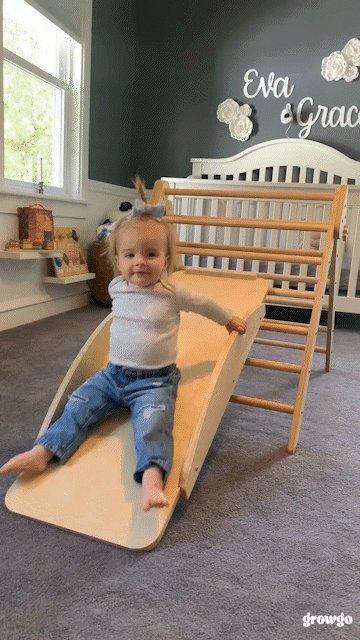
Becoming a parent is a journey filled with countless milestones, each carrying its own unique joy and pride. As a young mom, one such memorable moment for me was witnessing my toddler take those first wobbly steps and stand up all by herself. It’s a truly magical milestone.
My daughter stood up at 14 months. What’s the usual timeline?
Our supportive hands will always be there to guide our tiny humans through initial attempts to stand. Soon enough, they’ll be cruising along furniture with a determined grin. However, the journey to standing independently takes its own course.
- With help and support, toddlers can stand as early as 4-6 months.
- As they grow, they will try to pull up onto things. It’s around the age of 10-12 months when they can stand up while holding onto something for support.
- Standing up entirely on their own, at least for a few moments, often comes around 12-16 months.
Remember, every child is different and will learn at their own pace. These numbers only show the average milestone times but are not hard rules. I’m telling the story of my toddler’s journey to standing up, but your child will have their own journey, and that’s totally fine.

Babies develop their muscles through activity
Watching our little ones move is not only adorable but also important, as it’s proof of their development. From the early days of rolling over to the attempts at crawling, every movement plays a vital role. Here are some key things to keep in mind:
Exploration at their earliest
In the initial stages, babies explore the world by kicking their legs, wiggling their arms, and discovering their own limbs. These seemingly simple movements are the building blocks of muscle strength.
Tummy time
Tummy time is akin to a toddler’s gym session. Placing your baby on their tummy encourages them to lift their head and shoulders, training neck and upper body muscles.
Crawling
This phase not only promotes exploration but also strengthens the muscles in the arms, legs, and core. It’s a precursor to the challenge of standing up.
Toys that encourage movement
Introducing toys that encourage reaching and grasping, like soft rattles or textured balls, can spark interest and further enhance muscle development. These activities engage motor skills, coordination, and muscle control.
The ability to stand independently is the result of these cumulative efforts. As parents, we play the role of supporters, helping our children to grow healthy and strong.
Support is important, but independence is crucial
So, what is the one reason that helped my daughter fully stand up at the age of 14 months?
It’s her own independence. Plain and simple. But it doesn’t appear out of nowhere. It must be ENCOURAGED and in a responsible way.
The power of independence
Independence is a superpower for toddlers. Allowing them the space to explore, make choices, and attempt tasks on their own lays the groundwork for a resilient and self-assured individual. While standing up might seem like a small feat in the grand scheme, it’s a testament to their growing autonomy.
Learning through trial and error
Every tumble, wobble, and subsequent rise is a lesson in resilience. When toddlers are given the opportunity to try and fail, they learn not only about standing but also about overcoming challenges. Each attempt contributes to the development of problem-solving skills.
Building confidence in a safe way
Supervision is a must. So is support. When my baby wasn’t able to stand on her own, I was there to hold her. But I did hold her in a way that she could FEEL what it’s like to stand and what her body will need to learn. And when she started pulling up on things, I allowed her—while being there, ready to catch her if she fell, but allowing her to try. And so it goes on: you allow your little ones to try more things as they grow. Confidence is built one brick at a time, at the right time.
Encouraging exploration and curiosity
Independence and confidence go hand in hand with a child’s natural inclination to explore. Allowing them to investigate their surroundings and make choices fosters a spirit of curiosity that will make the child WANT to overcome whatever challenges they face.
We parents act as guides, offering a helping hand when needed but also celebrating the moments when our toddlers spread their wings. Independence and confidence should start forming from the early days so they can set the stage for a successful future.
My daughter’s attempts to pull up

In the beginning, my toddler’s journey resembled a wobbly dance through our living room. As she crawled around, she kept trying to stand up. The low coffee table was her first partner, providing a sturdy foundation for those tiny hands to grip. With each pull-up, a sparkle of determination lit up her eyes.
As days passed, the supporting cast expanded to include the couch, the bookshelf, and the Pikler triangle that we got her. Moving from one piece of furniture to another, my toddler’s confidence grew. And so did her strength. She was becoming better at it. This simple story of pulling up on various things showed the resilience found in the little victories of my daughter.
Progression to standing with support
The transition from pulling up on low furniture to supporting herself while standing marked a significant chapter in her development. The couch and Pikler triangle became her steadfast allies, providing the support she needed, along with my hands, gently supporting her when she lacked strength.
With each passing week, the once wobbly attempts became more balanced and controlled. As pulling up turned into supported standing, THAT turned into cruising. She needed, however, to hold onto something, but I witnessed a few moments of tentative tries to let go. The moment she did and stood there for a few seconds was incredible.
The role of the Pikler Triangle
One particular piece of play equipment emerged as a game-changer: the Pikler Triangle. This simple yet ingenious structure became an ally in teaching my little one to cruise, bridging the gap between crawling and standing.
While always keeping an eye out for safety, I loved seeing my daughter to try and get better. And she loved it, too. While it was a form of play for her, it was also a tool that fostered both physical and cognitive growth. This is a huge tip I would give to any parent: provide your kid with developmental toys. Make their environment a supportive one for exploration, and you’ll be boosting your little one’s growth!

Happy journey!
In the end, the journey to that first independent stand wasn’t just about physical milestones. It was a lesson in trust, resilience, and the beautiful messiness of parenting. So, here’s to every toddler finding their footing and every parent learning to let go, one wobbly step at a time.


